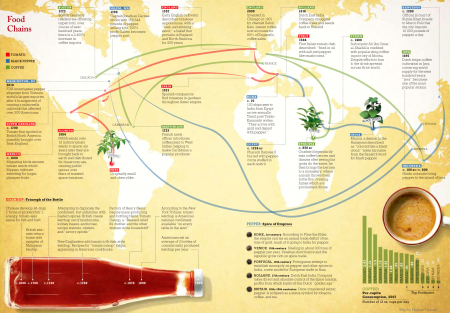- Seed savers: everyone’s got an angle, from Seeds of Hope and Change to Seed Bank Bingo.
- Italian lemons enjoying a renaissance. In California, natch.
- India registers Assam farmers’ traditional rice varieties. In other news, rice water “is also used as shampoo, according to community elders”.
- US$9 million to “implement and evaluate four approaches” to controlling Striga in Africa. One day we’ll know.
- Denver Botanic Gardens does amaranth.
- Evolution of bearded pigs. Good to know. Good to eat?
- Bioversity banana team guest blogs at Annals of Botany. But surely they have a blog of their own. No, wait…
- Agriculture is bad for your health.
Tomato, black pepper and coffee
No, those aren’t the ingredients for some kind of wacky new dish. But they do offer some insights into the global realpolitik and social status of the food bizniss, past and present.
Thanks to Rachel Laudan for pointing to Lapham’s Quarterly, source of that infographic — you’ll want to click on it to see it bigger and better — and much else besides.
Nibbles: Millet, Goat, Heirloom Veg, Tamarind, Rice domestication, Rice sustainability, Microbes, Competition
- The importance of multi-purpose crops in Africa.
- The importance of multi-purpose goats, everywhere.
- Target reader reviews The Complete Idiot’s Guide to Heirloom Vegetables.
- Tamarind charcoal loses out to tamarind drink, Malawian villagers rejoice.
- Has intellectual piracy been with us since humans first became engaged in agricultural production? AoB blog asks the tough ones.
- Land-use intensity and Ecological Engineering – Assessment Tools for risks and Opportunities in irrigated rice based production systems launched. Glad they have an acronym.
- Microbe diversity matters too.
- OK, so nobody nominated us, but the semi-finalists at the 3QD science writing competition have been announced.
Brainfood: Bean diversity, Rice domestication, Microbial interactions squared, Threat of extinction, Agroforestry, Species diversity
- Population structure and genetic differentiation among the USDA common bean (Phaseolus vulgaris L.) core collection. Subpopulations detected within usual Middle American and Andean genepools. The former was more diverse. Diversity was lower for domestication loci. One wonders whether game worth candle.
- Artificial selection for a green revolution gene during japonica rice domestication. There’s nothing new under the sun. Fuller fills us in.
- Positive plant microbial interactions in perennial ryegrass dairy pasture systems. Plant-microbe interactions can have significant positive impact on production of, and chemical inputs into and losses from, perennial ryegrass dairy pasture systems. Gotta love that agrobiodiversity.
- Plant growth promoting potential of Pontibacter niistensis in cowpea (Vigna unguiculata (L.) Walp.). And another one. New bacterium from Western Ghats fertilizes soil and helps cowpea to grow.
- Extinction risk and diversification are linked in a plant biodiversity hotspot. That would the Cape. Extinction threat (IUCN categories) is better explained by phylogeny than by human activity or plant traits. Go figure.
- The framework tree species approach to conserve medicinal trees in Uganda. Sort of like artificial keystone species. Lots of other cool stuff in the same issue of Agroforestry Systems.
- Use of topographic variability for assessing plant diversity in agricultural landscapes. By and large, more environmental variability means more plant diversity, in Switzerland. Maybe some crop wild relatives in there?
Brainfood: Baby’s veggies, Chickpea and drought, Vine cactus breeding, Paleolithic rabbits, California protected areas, Wild pigeonpea, Pecorino classification, Milk composition, Phenotyping, Wild peas
- Vegetables by Stealth: an exploratory study investigating the introduction of vegetables in the weaning period. Sneaking them into the diet is the most common strategy used by mothers to introduce their kids to vegetables. Reeeeeally?
- Assessment of Iranian chickpea (Cicer arietinum L.) germplasms for drought tolerance. Four out of 150 local landraces showed promise. It really is a numbers game, isn’t it?
- In situ induction of chromosome doubling in vine cacti (Cactaceae). Potentially valuable autopolyploids were produced. Not that it was easy or anything.
- Who brought in the rabbits? Taphonomical analysis of Mousterian and Solutrean leporid accumulations from Gruta Do Caldeirão (Tomar, Portugal). People did, that’s who, but only during the later Upper Paleolithic. Before that it was mainly owls.
- Protected areas in climate space: What will the future bring? Nothing good. Both novel and disappearing climates are over-represented in current protected areas, at least in California.
- Progress in the utilization of Cajanus platycarpus (Benth.) Maesen in pigeonpea improvement. Baby steps.
- Classification of pecorino cheeses using electronic nose combined with artificial neural network and comparison with GC-MS analysis of volatile compounds. Wait, there are different kinds of pecorino?
- The need for country specific composition data on milk. Well, you’ve got me convinced.
- Rate-distortion tradeoff to optimize high-throughput phenotyping systems. Application to X-ray images of seeds. So, let me get this straight, basically, gauging the optimal trade-off between speed and accuracy in high-throughput phenotyping systems depends on what you’re measuring? Who writes these grant applications?
- Experimental growing of wild pea in Israel and its bearing on Near Eastern plant domestication. First pea growers were either very patient or very quick workers.
